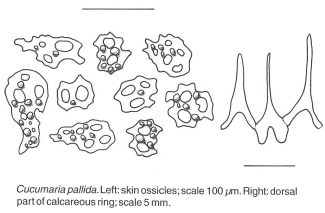pallida = pale
|
Cucumaria pallida feeds in the same way as C. miniata.
Spawning occurs from mid March to early May. Adult females produce long strands of eggs, 1 to 2 eggs wide, which break up in 12 to 15 minutes. Up to 8,800 tan-coloured eggs (mean diameter 504 μm) are produced. Each egg develops into a pelagic three-ringed doliolaria larva, which is repelled by light.
Because this species was assumed to be Cucumaria miniata, there is little published information on the biology of this species. McEuen (1987) recognized it as a different species based on its reproductive biology, but referred to it as Cucumaria fallax in his publications.
|
|
